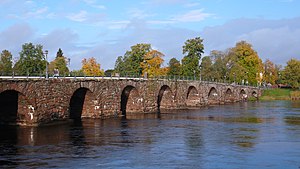Östra Bron
Coordinates: 59 ° 23 '5 " N , 13 ° 30' 48" E
| Östra Bron | ||
|---|---|---|
| Crossing of | Klarälven | |
| place | Karlstad ( Sweden ) | |
| construction | Granite stone arch bridge | |
| overall length | 168 | |
| Number of openings | 12 | |
| vehicles per day | Pedestrian, bicycle and bus traffic | |
| start of building | 1761 | |
| completion | 1811 | |
| planner | Not so Jacobsson | |
| location | ||
|
|
||
Östra Bron (German Ostbrücke ) is a stone bridge in Karlstad, Sweden . It spans the eastern branch of the Klarälven and thus connects the two districts of Norrstrand and Haga . The Östra Bron consists of 12 granite arches and is the longest stone bridge in Sweden at 168 meters.
In 1761 the construction of the Gamla stenbron (old stone bridge) or Östra bron began . At this point, the city's citizens realized they needed a bridge that could withstand the spring floods.
The 29-year-old builder Anders Jacobsson was responsible for the construction. He started building from the north. Fryksdals, Älvdals and Kils counties , as well as Nyed mining, were allocated 464 feet and ten piers of the bridge. The city was assigned 110 feet and three pillars from the south. The 4,000 cubic meters of stone were brought from Lamberg, Rudberg and Svinbäckberg.
The construction time was set for four years. In 1765 all stone pillars and part of the vault were completed. A wooden superstructure made the bridge more or less usable. It was inaugurated in 1797. Gustav IV Adolf was king of the country at this time and Nils Nilsson Silverskjöld was provincial head. The bridge structure was not completed until 1811.
According to a legend, the builder A. Jacobsson is said to have doubted the durability of the bridge and therefore jumped into the Klarälven and drowned himself, is not true. He died at home in Segersted in 1804.
In 1914 and 1915 the stone pillars on the river bed were reinforced with concrete and in 1956 the upper parts of the bridge were also reinforced. The bridge received electrical lighting as early as 1909. The lanterns were made of wood, but in 1923 they were exchanged for newer ones made of iron. At the southern end of the bridge was the eastern customs of the city. From there, the route stretched over the Lagberg between the old grammar school and the cathedral. There were mainly tanneries on the southern bank of the river.
The roads to Filipstad and Kristinehamn and Stockholm ran from the northern end of the bridge . The western and eastern cemeteries were built on both sides of it in 1800 and 1895. On the north side of the bank was the Sundsta Manor. There in the late 19th century Alfred Dahlgren ran a salmon canning factory and well water pumping from a spring. Both were sold internationally. The water was also channeled across the river and used in the old bath house.
swell
- Lennart Utgren: Sköna Värmland . Formula Five, Stockholm 2006 ISBN 91-631-8247-5
- carlstads-gillet.s.se

